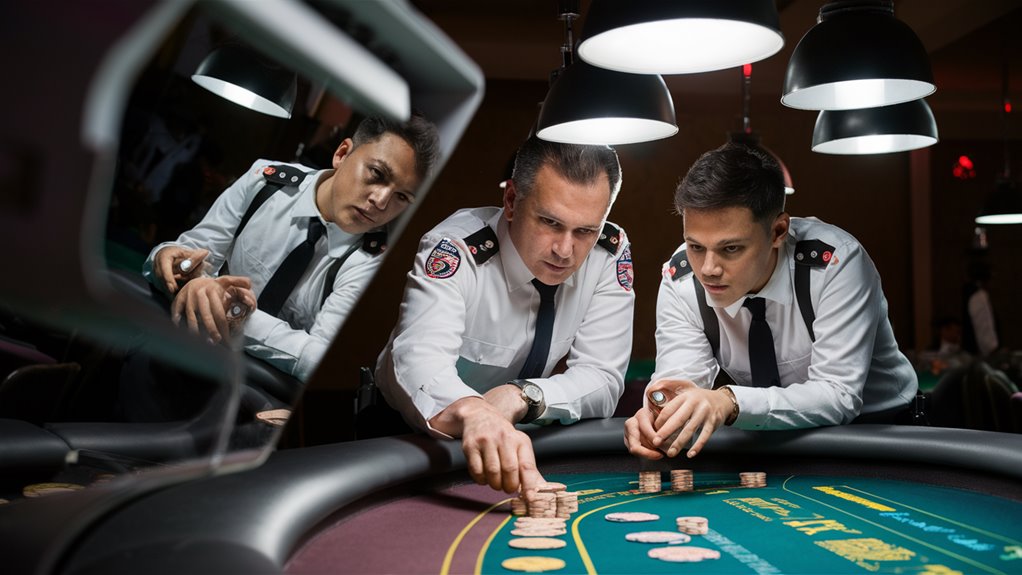Casino Security: Why Staff Training is Key to Spot Fraud

The Base of Casino Fraud Safety
Staff training is the main part of good casino fraud safety, using a three-level system. This method mixes classroom teaching, real practice, and mentorship programs to build a strong security setup. Modern casinos run training every three months and use real-life scenarios to stay alert to new dangers.
How to Spot and Tech Tools
Security staff learn to see key warning signs like:
- Odd bet patterns
- Avoiding cameras on purpose
- Secret signs between players
- Odd table acts
While AI cameras and RFID tracks make things safer, watching by people is still most vital. Tech helps but does not take over the need for sharp staff.
Making a Careful Security Mindset
Watching Performance and Rules
Regular skill checks and score tracking make sure standards stay high. Staff go through:
- Skills tests every three months
- Watching in real time
- Talks on how they are doing
- Training to spot complex tricks
Teams Working Together
Good fraud safety in casinos needs smooth work across all teams. Security steps are not just for the watch team but include:
- Table game staff
- Cash team 온카스터디
- Floor bosses
- Help desk staff
This joint effort builds a strong guard against smart fraud tries.
Common Casino Frauds
Fixing Games
Trick moves in casinos have grown a lot, with game tricks still being a top cheat way.
Fast hand moves include clever card swaps, adding bets after wins, and taking chips after losses.
Smart cheaters use marked cards, perfect dice moves, and roulette guess work to cheat.
Fake Items
Bad casino pieces are big risks for game places.
Crooks make very good fake chips, real-looking fake money, and false player cards.
New plans use copy slot coins and broken TITO ticket setups, letting wrong payouts through tech tricks.
Team Cheats
Organized cheat groups do complex multi-player scams with careful planning.
Dealer-player cheats depend on small signs, while ghost player moves make planned mix-ups.
Pro cheat teams use hidden watching gear and secret talk tools to swap game info at many tables.
New Dangers
Casino cheat ways always change to beat new safety steps.
Now, cheats bring in top tech with smart people tricks.
New tricks mix old moves with top digital tools, needing non-stop watch and fresh safety answers from game safety pros.
Training Tips for Staff
Tips on Training Casino Security Staff
Full Training Plan Use
Casino watching staff need full and deep training to learn both basic and top safety skills.
The best way uses a three-level training setup that mixes set learning, real use, and guided work.
Main Training Parts
Classroom Teaching Phase
Pro watching training starts with full class times focused on watching tech learning, act pattern study, and set write-up rules.
Security staff learn to spot small fraud signs and build key team talk skills with floor teams.
Real Security Practice
Real practice tasks use play roles where trainees work on spotting common cheat moves in set setups.
These practices make book smarts real through live use of safety steps and watching jobs.
Guided Work Time
The last part pairs new watch staff with pro watching guides for live shift watching.
This helpful work style makes book learning strong while growing key choice skills under real casino settings.
Watching and Growing Non-stop
Security skill checks involve keeping detailed scores and doing regular tests focused on:
- Face knowing how well
- Spotting odd acts
- Answer steps in emergencies
- Tech watching work
Needed update classes make sure security teams are up-to-date with new cheat moves and top watching tech. This ongoing learning keeps top safety steps and fraud stop skills.
Signs of Bad Acts
Signs of Bad Acts in Casino Safety
Spotting Odd Game Acts
Security experts must learn how to see act patterns that could mean likely crime on the game floor.
Several clear signs always show likely fraud or cheat tries, including often looking around, nervous hand moves, and trying to block camera views.
Team-Based Odd Acts
Planned cheat tries often show in small team acts. Key signs include:
- Secret signs between many players
- Planned spots around game tables
- Odd cell phone use
- Odd interest in how dealers work
- Knowing where cameras can’t see
Big Warning Signs
Bet Act Signs
- Odd bet patterns
- Sudden bet plan changes
- Small play with lots of chip buys
- Fast moves between tables
Dodging Watching Signs
- Planned spots to block cameras
- Odd knowing of camera spots
- Planned dealer mix-ups
- Long watching without playing
Risky Act Patterns
- Waiting around without playing
- Noting others’ game moves
- Watching dealer moves close
- Watching count steps
Many odd acts at once often show planned wrong acts more than single moves.
Security staff must keep a sharp watch on these mixed risk signs to spot possible dangers well.
Tech and People Watching
Using Tech and People for Watching

Top Watching Setups
Modern security watching mixes top tech tools with skilled people watching to build full defense setups.
The joining of clear camera networks, face knowing tech, and AI smart checks with trained people makes a strong safety setup. This mixed way lets us find threats fast while keeping an eye on detailed act study.
Tech Parts
Linked watching systems are key to modern security setups.
PTZ camera systems cover a lot with sharp watching.
Face knowing lists let us spot risks fast, while RFID tracks and top game checks spot odd patterns and odd stats right away. These auto-watching tools create a strong first guard line.
Skill in Watching
Pro watching workers are key for good security watching. Their skill in seeing small act signs, player talks, and silent signs add to tech tools.
Non-stop training in both old watching ways and new watching tech makes sure workers use all available tools while keeping needed human smarts.
Main Watching Parts
- High-def video watching
- Face knowing tech
- https://maxpixels.net/
- AI-based threat checks
- Real-time pattern checks
- Act watching systems
- Linked safety platforms
This mix of human smarts and tech growth creates a top safety place that changes with new challenges while keeping strong threat checks.
Making Good Answer Rules
Good Answer Rules for Casino Safety
Setting Key Safety Bases
Clear answer rules are key to good casino safety work.
Step-by-step plans make sure we answer fast and well to safety problems, where every second counts in stopping possible fraud or breaks. These base rules guard stuff while keeping how things run right.
Using Set Answer Plans
Breaking down complex safety problems into easy action parts makes work smooth. A strong rule plan includes:
- Contact lists for fast telling
- Guide on how to gather proof for event notes
- Threat color-coding for fast need knowing
- Time checks for how we’re doing
Training and Doing Well
Regular safety tests and real-case training make rule use better through:
- Tight timing
- Better talk rules
- Team work plans
- Watching step-ups
- Floor boss answer steps
Notes and Steady Bettering
Set event telling and deep after-event study drive rule bettering. Key parts include:
- Detailed event notes
- Score tracking
- Checking how good rules are
- VIP perks worth thousands
- Putting in better plans
- Team thoughts in the mix
These set parts create a full safety setup that changes with new threats while keeping how we work top-notch.
Building a Safety Mind
Making a Strong Safety Mind: Top Plans for Groups
The Three Main Parts of Safety Top-Notch
A strong safety mind really needs three key parts: shared beliefs, group watch, and each one’s answer.
When groups truly mix these parts, safety changes from just a list to a big part of how things run.
Putting in Strong Safety Beliefs
Clear talking is key to putting safety beliefs in all teams.
Every team member must get that keeping stuff safe, guest safety, and name care are jobs for all.
Regular safety talks build key times for looking at problems, making rules better, and sharing top ways.
Building Group Watch
Starting team telling setups grows how careful about safety we are as a group.
A good telling setup lets staff point out odd acts without fear.
This way grows a place where acting before problems is just what we do.
Making Each One Answer
Safety work scores in staff tests make sure we can see results.
Clear job lists, steady learning plans, and often talks on how we’re doing set sure hopes for following safety.
This set way makes each one own up to keeping safety rules.
Top Plans to Put in Place
- Make full safety rules
- Set steady learning times
- Make clear telling paths
- Watch how we follow rules
- Give steady talks on how we’re doing
By putting these parts in place in a set way, groups can build a strong safety mind that really guards stuff, people, and how things run.
Checking If Training Works
Does Security Training Work? Checking Success
Clear Measures for Checking Training
Figuring out if safety learning works needs set measuring through data-run checks and what we can see.
Key show signs include how we answer, how well we spot fraud, and how we stop safety breaks.
Looking at our work before and after learning shows us straight gains and how the program changes things.
Deep Check Setups
A full safety check setup brings in many check tools:
- Often skill tests
- Real-case tests
- Deep reviews on staff
- Monthly safety skill checks
Safety folks face hard checks of their threat spotting skills, how they follow rules, and how aware they are of the scene.
Gathering clear data helps us look at trends and make our work better.
Watching How Well Programs Work
How well safety plans work is tracked through many ways:
- How guests think we’re doing
- How well watching systems work
- Staff work signs
- How well we answer to problems
Cross-checking work info with learning setup shows us strong parts and places needing better steps.
This proof-driven bettering way keeps making our plans better and fits them to new safety threats.
Set measuring of these signs lets us keep making our plans better and keeps learning in line with changes in safety needs.
